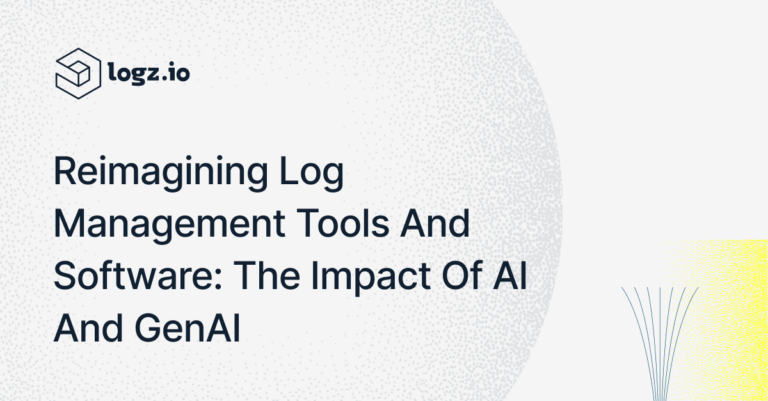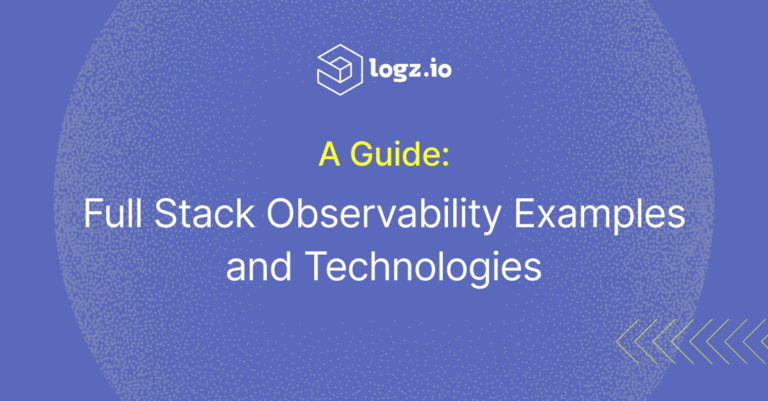
Fundamentals of a Successful Logging and Observability Strategy
August 21, 2024
Your team is responsible for ensuring the reliability and performance of your organization’s critical applications and infrastructure.
What keeps you up at night?
Your applications are more complex, distributed and cloud-native than ever, meaning that understanding what’s happening under the hood has never been more complex than it is now.
Is it system bugs, or data bottlenecks? Chasing alerts for latency or service degradation that may or may not be business-critical? How about the inability to locate specific problem areas because there’s so much to sift through?
Building a better understanding of all of these issues is clearly where logging and observability strategy can play a major factor. Together, these related practices provide the detailed insights needed to monitor, debug, and optimize systems effectively.
However, while logging and observability are often discussed in tandem, and certainly linked, these monitoring and troubleshooting efforts are not synonymous. Logging is a crucial component of observability, and full stack observability encompasses much more.
In this guide, we’ll delve into the fundamentals of logging and observability, explore their importance in modern systems, and provide guidance on how to implement their processes effectively—so you can sleep better at night instead of worrying about your systems.
Logging and Observability 101
We know if you’re reading this, you may already be well aware of the ins and outs of logging and observability. But for the sake of clarity and level-setting, let’s start with some basic definitions of what we’ll be discussing.
Logging is the practice of recording events that occur within a system. These records, known as logs, are time-stamped messages that provide a detailed account of what the system is doing at any given moment.
Logs can capture a wide range of information, from simple error messages to detailed transaction records, and are invaluable for troubleshooting and debugging. These provide the information needed to address issues that can arise in your data.
Observability, on the other hand, is a broader practice that refers to the ability to understand the internal state of a system based on the data it produces. Observability is about gaining deep insights into a system’s behavior and performance, allowing for proactive detection of issues and faster resolution times.
Top down, observability is specifically defined as standing on three pillars of telemetry data: logs, metrics, and traces. Each pillar provides a unique perspective on system behavior, and together, they can offer a holistic view of what’s happening inside a system.
As part of your overall observability strategy, log management is a critical component. Log management should afford you the opportunity to create dashboards and visualizations, set up alerts, query your data and get answers fast during incidents like latency or downtime that impact your bottom line.
While logs are a critical part of observability, the foundational performance data generated in this stream are further complemented by metrics and traces; when bringing all of this telemetry together it provides a comprehensive view of system health. Compared to logging alone, this combined insight provides richer context and clear indications of what’s happening in your system through cross-referencing and event correlation.
With observability, organizations can also hope to evolve from reactive to proactive management of their systems. Instead of merely reacting to failures as they occur, teams can anticipate potential issues, identify performance bottlenecks, and ensure that their systems are running optimally at all times. This shift is crucial in maintaining the reliability, availability, and scalability of modern applications.
Why Logging Remains Critical to Observability
All of this said, in the current era of microservices, containerization, and cloud-native architectures, systems have become far more distributed and complex. Traditional log management solutions and monitoring approaches, which focus on the basics of monitoring the status of individual components, don’t work as well when architectures become more and more ephemeral.
Practical log management starts with understanding what’s happening in your environment, and while logs are often considered the most basic of telemetry types, they are critical to getting the most complete and accurate view issues that can pop up in your system. When there are errors, latency, data saturation, bugs or bottlenecks, your logs can be the best place to discover what’s happening and begin your path to finding solutions.
We know that observability has emerged as a critical capability in modern systems, so teams like yours can understand complex interactions across distributed services, detect anomalies, and respond to incidents before they impact users. But many organizations aren’t getting it right.
As evidence of this claim, in the 2024 Observability Pulse survey, practitioners from 500 global IT organizations were asked about where they are on their observability journey. Just 10% said they’ve achieved full observability.
We find that many organizations are struggling to achieve full observability because they aren’t getting logging right. Much of this is attributable to an inability to cut through mountains of available log data to focus on the most critical issues. There’s also the inherent complexity of carrying out complicated investigations to understand the root cause of issues.
In essence, the “needle in a haystack” problem persists in logging, and that’s what can prevent organizations from getting to the full observability state they want to achieve.
They don’t know where to look when there are errors or latency, and if they do know where to look, they can’t find what they’re looking for. This can cause damaging downtime in systems that erodes end user confidence and can impact your organization’s bottom line. It also leaves engineering teams frustrated that they cannot make headway on a daily basis in markedly improving their systems.
Challenges in Logging and Observability
As we’ve noted, achieving effective logging and observability is not without challenges. Several common issues can hinder the implementation and effectiveness of observability strategies.
Data Silos and Volume Issues
One of the biggest challenges is the proliferation of data silos. Logs, metrics, and traces are often stored in separate systems, making it difficult to correlate them and gain a holistic view of the system. Moreover, the sheer volume of data generated by modern applications can be overwhelming, leading to storage and performance issues.
Instrumentation and Configuration Challenges
Proper instrumentation is essential for effective observability, but it can be challenging to get it right. Instrumenting an application to capture the necessary logs, metrics, and traces requires careful planning and often involves modifying code, which can be time-consuming and error-prone. Additionally, maintaining and updating instrumentation as the application evolves adds to the complexity.
Multiple Tools and Vendor Management
With the wide variety of observability tools available, organizations often find themselves using multiple tools from different vendors. This can lead to integration challenges and increased management overhead, as teams must ensure that data from different sources is correctly correlated and analyzed. Moreover, vendor lock-in can be a concern, limiting flexibility and driving up costs.
Best Practices for Implementing Observability
None of this is to say that modern log management and observability can be achieved easily, as properly implementing logging and observability requires careful planning and execution. However, we know that following a few proven best practices can significantly help organizations avoid common pitfalls and maximize the value of their observability efforts.
Expert Tips and Common Pitfalls
- Start with the Basics: Begin by implementing basic logging, metrics, and tracing. Ensure that all critical components of your system are instrumented before moving on to more advanced features.
- Centralize Your Data: Use a centralized platform to collect and analyze logs, metrics, and traces. This reduces complexity and makes it easier to correlate data from different sources.
- Automate Where Possible: Leverage automation to reduce the manual effort required to manage observability. Automated alerting, anomaly detection, and root cause analysis can save time and improve response times.
- Invest in Training: Ensure that your team is well-versed in the tools and techniques of observability. Regular training and knowledge-sharing sessions can help keep everyone up-to-date with best practices.
- Avoid Data Silos: Ensure that observability data is accessible to all relevant teams. Data silos can lead to incomplete or misleading insights, making it harder to diagnose issues.
- Iterate and Improve: Observability is not a one-time project. Continuously refine your observability strategy based on feedback, new requirements, and emerging technologies.
The Role of AI and Machine Learning in Observability
We also need to highlight the incredibly important role that AI and machine learning are playing in observability as a whole, and log management, in particular. As noted, when the complexity and scale of systems grow, the sheer volume of data generated can become overwhelming. This is where AI and machine learning help massively, revolutionizing the way logging and observability can be approached.
AI-driven log management and observability tools can automatically detect anomalies, correlate events across different sources, and even predict potential issues before they occur. By learning from historical data, these models can help identify patterns that might not be immediately obvious to human operators. This enables proactive maintenance and faster root cause analysis, reducing downtime and improving overall system reliability.
Organizations seeking to get the best, most-efficient AI experience for observability need to consider tools that give practitioners with an AI-copilot capability, one that allows them to converse directly with data. Automated investigation is another capability to consider, where AI will provide step-by-step recommendations for remediating problems.
Moreover, AI can assist in noise reduction by filtering out irrelevant data and highlighting what truly matters. In environments where thousands of events occur every minute, this capability is invaluable for focusing on critical issues without being distracted by noise.
Discover the Ease of Logging and Observability Through Logz.io
At Logz.io, we have helped enterprises of all sizes manage their logging and observability challenges for years. Whether it’s been to help customers optimize their existing open source observability implementations, or migrate away from open source or costly proprietary platforms, Logz.io has provided observability solutions at scale.
Through Logz.io’s Open 360™ platform, we offer a Log Management solution that has been reinvented to meet modern use cases and provide superior value over traditional tools. We’ve made it easier and faster to find critical data in your logs so you can identify issues and troubleshoot more quickly. Our data optimization and storage solutions also simplify the process of accessing your important data and also helps with cost efficiency.
We’re also working to bring the power of AI to your observability practice through the Observability IQ™ Assistant. Acting as your observability copilot, you can ask the IQ Assistant questions about your data and get real-time insights and answers. It acts as an extension of your team and helps you get the information you need fast to resolve production issues.
As we look to the future, it’s clear that logging and observability will continue to be vital components of maintaining robust, reliable systems. By staying ahead of emerging trends and technologies, and by continuously refining our observability practices, we can ensure that our systems remain resilient, performant, and secure in an increasingly complex digital world—so you can sleep better at night.
Discover how Logz.io can help you meet your needs by signing up for a free trial today.




